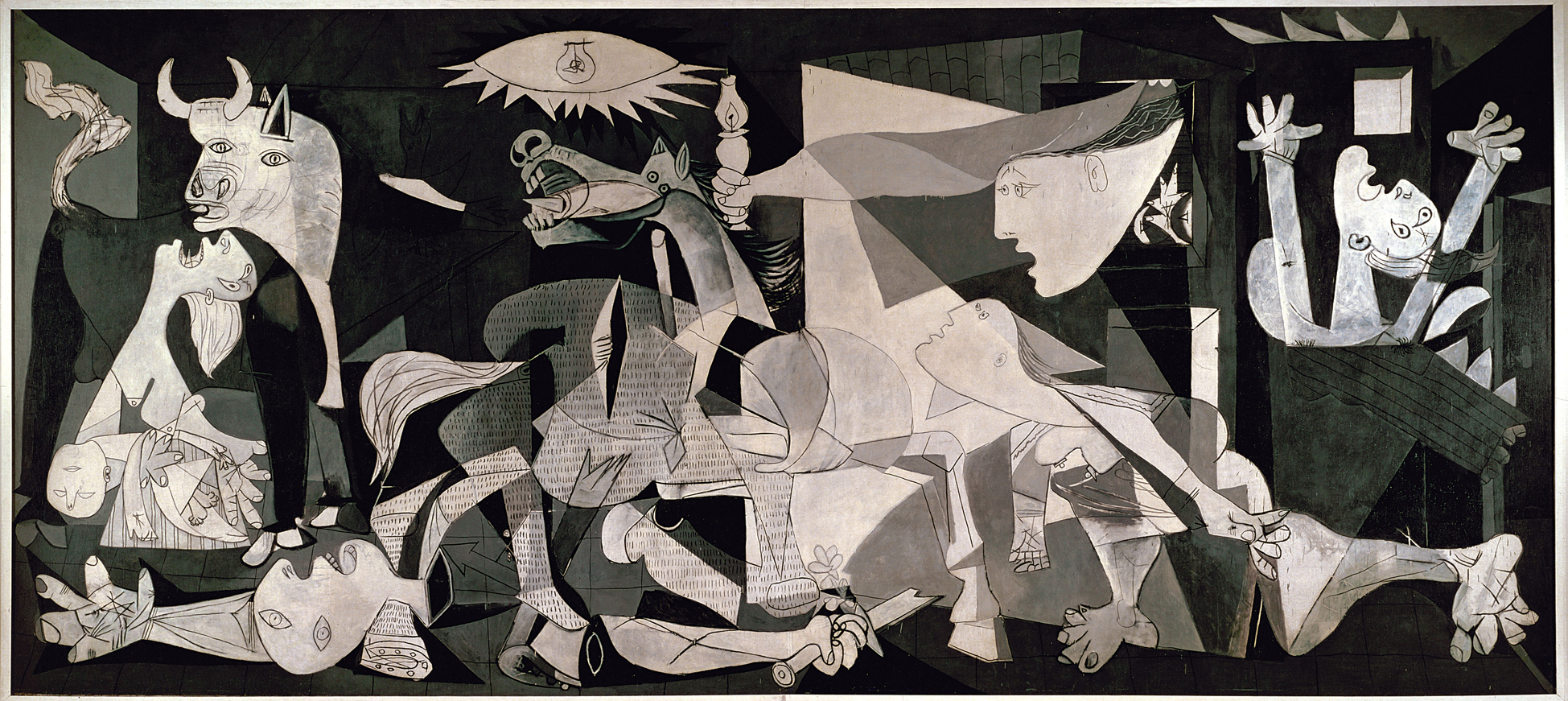
In this work Pablo Picasso combined Synthetic and Analytic Cubism with several more traditional symbols. This stylistic choice reveals Picasso’s intense dislike for war and brutality. The painting was created in response to the bombing of the town Guernica during World War Two. The painting almost completely lacks all color, with variation solely in back, gray and white. The lack of color is in keeping with the theme of death and dying. The painting is divided into three sections. There is a central triangle with a rectangle like shape on either side of it. The bottom part of the triangle reaches from a dismembered and decapitated soldier to a woman running vainly. The horse, which is almost in the center of the picture, represents the death of civilization while Liberty, portrayed by a woman carrying a lamp, attempts to save it. Hope is seen in the combination of an eye shape with a sun directly above the dying horse. Religious motifs are seen in a woman dying at the far right in a gesture reminiscent of the crucifixion and a woman holding a dead baby in her lap in a pose reminiscent of the Madonna at the far left. A Minotaur is also depicted. The minotaur became the representation of modern tyranny for Picasso. Although the shapes are seemingly disconnected and varied they are all connected through the distorted cubist shapes. The sharp angles add to the sense of despair and brutality. The mutilation of the human form is shown both through slashed feet, eyes twisted out of their sockets and disfiguration into sharp, unrealistic shapes. The paintings use of cubism is ultimately used to portray the inhumanness of war and tyranny, its total alienation and disregard of human life.



 Self Portrait as Saint Paul reflects the shifting attitude of the famed artist. He portrays himself as elderly and humble rather than as the successful, pompous bourgeoisie artist of his earlier years. The painting maintains the rich coloring and drama created by contrast in light that was typical of Rembrandt’s work; however, the painting has a more resigned air to it. Saint Paul’s sword, his traditional attribute, is barely visible. The worn book that Saint Paul is holding, on the other hand, is extremely dominant. Rembrandt intentionally places the viewer’s attention on the less aggressive aspects of the man. He looks up from the book, with his shoulders slightly shrugged. This adds to the sense that he is a defeated man. His slightly tilted head in conjunction with with Rembrandt’s loose brushwork emphasize his sagging cheeks. Rather than giving Saint Paul the traditional halo, he paints a yellow band into the cloth hat he is wearing. This merges light and color in a non-typical way. As an aging artist, Rembrandt places his own experiences and weariness with the world into those of Saint Paul. The man pictured looks far from heroic, rather he looks defeated and weighted down. This painting features a dark backdrop with a lighter, glowing light on the subject. This creates a dark surrounding plane which Saint Paul seems to emerge from.
Self Portrait as Saint Paul reflects the shifting attitude of the famed artist. He portrays himself as elderly and humble rather than as the successful, pompous bourgeoisie artist of his earlier years. The painting maintains the rich coloring and drama created by contrast in light that was typical of Rembrandt’s work; however, the painting has a more resigned air to it. Saint Paul’s sword, his traditional attribute, is barely visible. The worn book that Saint Paul is holding, on the other hand, is extremely dominant. Rembrandt intentionally places the viewer’s attention on the less aggressive aspects of the man. He looks up from the book, with his shoulders slightly shrugged. This adds to the sense that he is a defeated man. His slightly tilted head in conjunction with with Rembrandt’s loose brushwork emphasize his sagging cheeks. Rather than giving Saint Paul the traditional halo, he paints a yellow band into the cloth hat he is wearing. This merges light and color in a non-typical way. As an aging artist, Rembrandt places his own experiences and weariness with the world into those of Saint Paul. The man pictured looks far from heroic, rather he looks defeated and weighted down. This painting features a dark backdrop with a lighter, glowing light on the subject. This creates a dark surrounding plane which Saint Paul seems to emerge from.